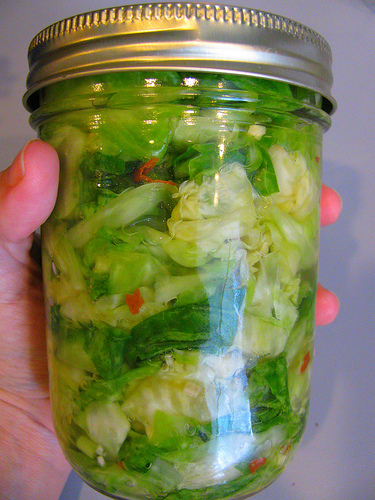
There are a million different ways to make kimchi, no I’m not exaggerating! There are even different ways to spell it: Kimchi, Kimchee, Kim-chee, Kim-chi, Kim chee, gimchi. I’ve seen them all, they’re all correct spellings except the hyphens, not sure where that came from! When I lived in Korea as a kid, I simply called it “stinky cabbage”. It can be an aquired taste, and little by little, I’ve aquired it. Kimchee is a great way to use up the abundance of cabbage we were getting with our CSA when I don’t want to keep making coleslaws. At our pa’ina, several people asked, “What is kimchee?” Basically, it’s spicy, fermented cabbage, and yes, it’s stinky.

Kimchee can be made with a variety of vegetables, but cabbage is the most common. Cabbage kimchee is traditionally made with Napa Cabbage (or baechu), but can also be made with any green or red cabbage. There are references to kimchee that go as far back as 3000 years, and originally it was made with cabbage and beef stock. Traditionally, kimchee uses a red chili paste for heat and flavor, but I had an auntie in Hawaii who wanted her kimchee to be green (rather than red), so simply used chopped red chilies. According to wikipedia, it sounds like her recipe is a more Northern Korean recipe, but don’t hold that against it! This is her recipe, adapted to use a regular green cabbage, although you can totally use napa cabbage if you have one. It’s a great “starter” kimchee if you haven’t tried it before or aren’t sure if you like it. It has a milder flavor than most traditional kimchees. Another interesting thing about this recipe, is that rather than grating or cutting the cabbage, you simply pull each leaf off the cabbage, and it’s really fun to see them getting more and more compact as you get to the center of the cabbage.

Two important things in making the kimchee, make sure all the cabbage is submerged in the brining water, and wear gloves if you have sensitive skin. I put a plate in the brining bowl, and set a large pot on top of it, this held the cabbage down to get nice and salty. I actually didn’t wear gloves, but washed my hands immediately after mixing the kimchee, was careful not to touch my face, and not to get chili under my fingernails. If you’re wondering why you should give kimchee a try, not only is it an easy way to try a staple of Korean cuisine, but it also has some great nutritional benefits. It’s a low calorie way to get lots of fiber, as well as being vitamin rich and aiding in digestion. Some studies have found certain types of kimchee to prevent gastric cancer! Plus, you don’t have to limit yourself to eating it on its own. It’s great in fried rice or soups, I served it as a side at our Hawaiian Pa’ina. So give this a try, if you don’t like it, it keeps over 6 months in a jar in your fridge, so you’ll have plenty of time to pass it along to someone else!

Beginner’s Kimchee
makes about 1 pintIngredients
1 small to medium sized green cabbage
4 cups of cold water
3 TBS of sea (or kosher) salt
5 cloves of fresh garlic, finely chopped
1 tsp grated fresh ginger
3 stalks fresh green onions (scallions), chopped
1-2 dried red peppers chopped (depends how spicy you want it)
2 tsp of sugar
Instructions
Separate and rinse cabbage leaves. Sprinkle 2 TBS of sea salt evenly on cabbage leaves. Place salted cabbage leaves in a large bowl, add the 4 cups of cold water. Put a plate (smaller than mouth of bowl) on top of cabbage and weight down to keep all the cabbage submerged. Refrigerate overnight.
The next day, remove cabage leaves, rinse thouroughly and shake excess water off. Dump your salty water from the bowl, and put the cabbage leaves back in.
Add garlic, green onions, ginger, dried red pepper, sugar, and 1 tablespoon of salt. Use your hands to rub seasoning into all the cabbage leaves. (you may want to use gloves!)
Transfer seasoned cabbage leaves into a glass jar (I was able to fit it into a pint jar). Push down hard on cabbage leaves as they stack up inside the bottle. Liquid will begin coming out of the leaves as you press down, this is good! You can also pour in liquid from the bowl you mixed it in.
Leave at least 1/2 inch of room in the jar before capping it tightly with a lid. Keep the jar on your counter or in a cupboard (out of direct sun) for 2-3 days.
When ready to serve, use your kitchen shears to cut cabbage leaves into 2 inch pieces before serving.
Approximate cost/serving: So cheap! A head of cabbage is around $1, the jar of kimchee costs about $1.40 to make, and serves 8 as a side dish. So, only 18 cents a serving!
Vegan/Gluten Free: Yes and yes, vegan too!

Your hand looks so pink when your holding the green cabbage.
Yum!! I love kimchi. I’ve always been a bit intimidated about making mmy own at home. I may have to try it sometime. Thanks for putting a beginners recipe. ;-D
oh wow…it sounds great. I’ve never heard of Kimchee before
great post and history its good stuff but does smell!
That word just about gives me nightmares. My ex-husband’s mother was from Korea, and this was a staple in her home. If I didn’t make him eat it shortly after bringing it home my entire refrigerator would smell of Kimchi when you opened the door. Burned my nose. True story.
doin a school project and i used ur sight to get a little info about kimchee need extra credit. FYI im only ten
Waahh i read this too late. You see i was watching a video of how to make kimchi but the person didnt say that it could affect sensitive hands so OMG MY HANDS ARE LIKE ON FIRE RIGHT NOW!!! Cold water only helps while i have my hands under it 🙁 im in sooo much pain right now! good thing i have high pain tolerance
Oil breaks the heat it’s the only thing that does just put some olive oil or veggie oil or any oil and put on your hands and rub them like your washing them then just wash with dawn or hand soap that cuts grease
Hi there, I made kimchi for the first time about 6 months ago–previously I had made sauerkraut a few times (which I love). My first batch using napa cabbage seemed too salty using a reportedly traditional method, But my second batch using a different type of cabbage (I think it was pointed cabbage) was a lot less salty and far more palatable when I used it in combination with a sauerkraut recipe. I have to say that my favorite ferment to date is a red cabbage ferment, with a grated carrot, coriander seeds (about a tsp), 3 garlic cloves, about an inch of grated ginger, fennel seeds, cardamom seeds, and caraway seeds. (All seeds about 1 tsp each.) It tasted vile for about the first 3 months (too strong), then I refrigerated it and left it for about another 3 months and low and behold, it tasted wonderful (and no bad side effects). I think fermented cabbage can be left for far more than six months in the fridge and possibly becomes even tastier the older it gets.
I forgot to say that in my second batch of kimchi, I used a 2% ratio of salt, based on the weight of ALL ingredients and let them sit under a heavy plate overnight (actually it turned out to be about 18 hours, but it did no harm). This is the typical ratio of salt to vegetables used in sauerkraut and I have to say it results in a far more palatable ferment (although my kimchi which was too salty at first is losing the saltiness with age–so don’t chuck out your kimchi after a week if it’s too salty, let it sit on the counter for another few weeks and then in the fridge for some months (frustrating as that might be).